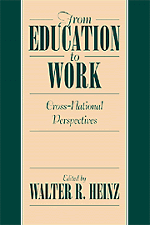Book contents
- Frontmatter
- Contents
- Contributing Authors
- Preface
- Introduction: Transitions to Employment in a Cross-National Perspective
- Part I Social Origin, Gender, and Transition Patterns
- 1 Social and Geographical Mobility 20 Years after High-School
- 2 Diverse Directions: Young Adults' Multiple Transitions
- 3 New Routes to Employment: Integration and Exclusion
- 4 From Education to Employment: Occupations and Careers in the Social Transformation of East Germany
- Part II Education and Labour Markets: Work Experiences, Skills, and Credentials
- Part III Changes in the Social Context of Transitions
- References
- Index
2 - Diverse Directions: Young Adults' Multiple Transitions
Published online by Cambridge University Press: 30 September 2009
- Frontmatter
- Contents
- Contributing Authors
- Preface
- Introduction: Transitions to Employment in a Cross-National Perspective
- Part I Social Origin, Gender, and Transition Patterns
- 1 Social and Geographical Mobility 20 Years after High-School
- 2 Diverse Directions: Young Adults' Multiple Transitions
- 3 New Routes to Employment: Integration and Exclusion
- 4 From Education to Employment: Occupations and Careers in the Social Transformation of East Germany
- Part II Education and Labour Markets: Work Experiences, Skills, and Credentials
- Part III Changes in the Social Context of Transitions
- References
- Index
Summary
This chapter looks at the attitudes and experiences that youth have of a series of transitions as they move from their teenage years to become young adults. This examination is informed by the life-course perspective, which, as Heinz (1996a, p. 3) notes “focuses on socially recognized sequences of transitions.” Heinz also notes the importance of longitudinal research to “uncover the dynamics of various transitions as they construct or feed into life trajectories” (Heinz, 1996, p. 3). Our analysis presents data from a longitudinal study of Canadian youth to help describe some of these dynamics.
Relationship to the Literature
The life-course literature (Abeles, 1987; Callahan & McClusky, 1983; Clausen, 1986; Dragastin & Elder, 1975; Elder, 1974; Elder, 1985; Heinz, 1991a; Hogan, 1981; Jones & Wallace, 1992; Kerckhoff, 1990; Oppenheimer, 1981; Rossi, 1985; Troll, 1985) emphasizes the importance of transitions. These include transitions within and between educational and occupational and marital–familial paths (Elder, 1985). This perspective also recognizes the relevance of the historical and structural context in which individuals undertake these transitions. “People make social history even as they are influenced by historical change” (Elder & Caspi, 1990, p. 108). Different transitions make up what life-course theorists see as careers or trajectories, “social strands of a life course in which persons invest themselves or (into which they, (V.T./E.D.L.) are thrust” (Clausen, 1986, p. 30).
- Type
- Chapter
- Information
- From Education to WorkCross National Perspectives, pp. 46 - 64Publisher: Cambridge University PressPrint publication year: 1999
- 7
- Cited by



